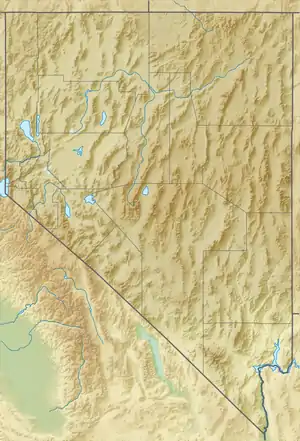Wild Horse Reservoir
Wild Horse Reservoir is a man-made lake in Elko County, Nevada in the United States. The reservoir was initially created in 1937 by the construction of Wild Horse Dam. In 1969, a new concrete single-angle arch dam was constructed by the United States Bureau of Reclamation for the Bureau of Indian Affairs with a height of 87 feet (27 m) and a length of 458 feet (140 m) at its crest. The original 1937 dam was left in place and is still partly visible. The newer dam doubled the size of the reservoir.[3]
| Wild Horse Reservoir | |
|---|---|
 Wild Horse Reservoir viewed from northwest | |
 Wild Horse Reservoir Location of Wild Horse Reservoir in Nevada | |
| Location | Elko County, Nevada |
| Coordinates | 41°40′0.32″N 115°48′24.99″W[1] |
| Type | Reservoir |
| Primary inflows | Owyhee River, Hot Creek, Penrod Creek, Warm Creek, Poorman Creek |
| Primary outflows | Owyhee River |
| Basin countries | United States |
| Surface area | 2,830 acres (11.5 km2) |
| Average depth | 40 feet (12 m) |
| Max. depth | 70 feet (21 m) |
| Water volume | 71,500 acre feet (88,200,000 m3)[2] |
| Surface elevation | 6,208 feet (1,892 m) |
The reservoir impounds the Owyhee River for flood control and irrigation storage, part of the larger Duck Valley Irrigation Project. The dam and reservoir are owned and administered by the BIA, and leased to the nearby Duck Valley Indian Reservation (Sho-Pai). Recreation on the lake includes fishing for trout, bass, catfish and perch. The state of Nevada also maintains the adjacent Wild Horse State Recreation Area.[4]
The small community of Wild Horse is located on the south shore.[5]
Gallery
 Double dams of Wild Horse Reservoir
Double dams of Wild Horse Reservoir Wild Horse Reservoir viewed from rock outcrop above dam
Wild Horse Reservoir viewed from rock outcrop above dam Wild Horse Dam viewed from downstream
Wild Horse Dam viewed from downstream Sign describing Wild Horse Dam
Sign describing Wild Horse Dam
Climate
Wild Horse Reservoir has a humid continental climate (Dfb) bordering on a subalpine climate (Dfc). Summers are warm to hot with brisk nights, and tend to be drier than other times of the year. Winters are very chilly with heavy snowfall and nights near zero. The snowpack usually peaks during February at around 19 inches (48.3 cm).
| Climate data for WILD HORSE RESERVOIR, NEVADA | |||||||||||||
|---|---|---|---|---|---|---|---|---|---|---|---|---|---|
| Month | Jan | Feb | Mar | Apr | May | Jun | Jul | Aug | Sep | Oct | Nov | Dec | Year |
| Average high °F (°C) | 31.8 (−0.1) |
35.3 (1.8) |
43.5 (6.4) |
52.0 (11.1) |
61.6 (16.4) |
71.9 (22.2) |
83.2 (28.4) |
82.6 (28.1) |
72.6 (22.6) |
60.0 (15.6) |
42.7 (5.9) |
33.6 (0.9) |
55.9 (13.3) |
| Average low °F (°C) | 2.6 (−16.3) |
4.1 (−15.5) |
16.5 (−8.6) |
24.2 (−4.3) |
30.4 (−0.9) |
35.6 (2.0) |
40.2 (4.6) |
38.8 (3.8) |
30.3 (−0.9) |
22.2 (−5.4) |
15.4 (−9.2) |
5.8 (−14.6) |
22.2 (−5.4) |
| Average precipitation inches (mm) | 1.63 (41) |
1.25 (32) |
1.28 (33) |
1.35 (34) |
1.74 (44) |
0.91 (23) |
0.66 (17) |
0.53 (13) |
0.55 (14) |
0.64 (16) |
1.57 (40) |
1.80 (46) |
14.22 (361) |
| Average snowfall inches (cm) | 26.9 (68) |
19.1 (49) |
13.9 (35) |
9.8 (25) |
4.6 (12) |
0.3 (0.76) |
0 (0) |
0 (0) |
0.2 (0.51) |
1.9 (4.8) |
17.2 (44) |
25.1 (64) |
121.0 (307) |
| Source: The Western Regional Climate Center [6] | |||||||||||||
References
- "Wild Horse Reservoir". Geographic Names Information System. United States Geological Survey. Retrieved Jan 17, 2021.
- United States Geological Survey (2013). "Wild Horse Reservoir" (PDF). Retrieved 2015-01-11.
- http://www.ndow.org/Bodies_Of_Water/Wildhorse_Reservoir/
- http://parks.nv.gov/parks/wild-horse-state-recreation-area/
- "Wild Horse, Nevada". Geographic Names Information System. United States Geological Survey.
- "WILDHORSE RESERVOIR, NEVADA (269072)". Retrieved January 10, 2016.
External links
| Wikimedia Commons has media related to Wild Horse Reservoir. |